This module has been designed for RC2014 by Marco Maccaferri. It provides VGA text at 80×25 with 16 colors, ANSI / VT-100 terminal emulation, and USB keyboard support.

Documentation and Suppliers
| Item | Source |
| Documentation | Developer’s website |
| PCB design files | OSH Park |
| PCB (to purchase) | Tindie: VGA serial terminal PCB |
| Kit (to purchase) | Tindie: VGA serial terminal kit |
Standalone Setup
The terminal module allows an RC2014 based system to work without a computer acting as a terminal. Here it is shown with SC126 (Z180 Motherboard), an old Samsung VGA monitor, and a Logitech USB keyboard.

Compatibility
I’ve tested the module with a range of RC2014 bus based systems and found it to work well with all of them. The only bus requirements are a 5 volt supply and RX/TX signals on the usual backplane pins.
One word of warning: RomWBW has traditionally shipped with the baud rate set to 38400 on systems where the baud rate is software selectable. Typically, these are systems using a Z180 CPU, such as SC126 and SC130. This baud rate is not compatible with the terminal module running the supplied firmware. At the time of writing the standard distributions of RomWBW for RC2014 based systems with configurable baud rates has just been changed to 115200 baud. This change will take a while to filter through to new kits but will ultimately fix the compatibility issue.
Here are a few systems I tested:
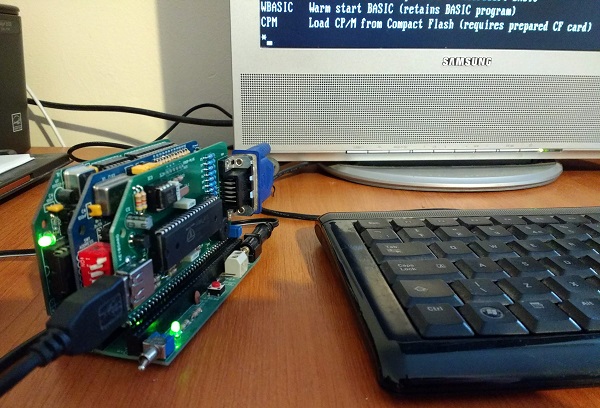
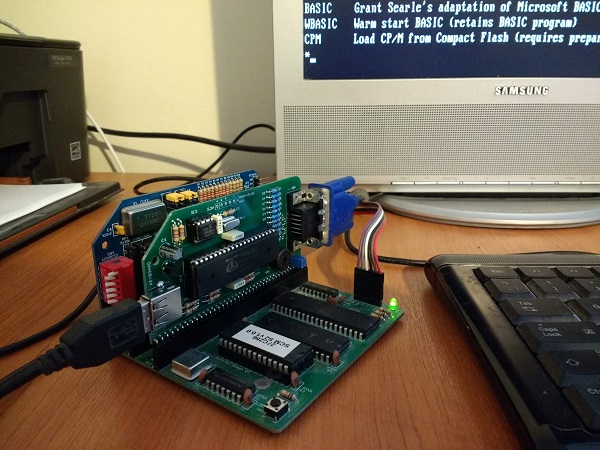


The Kit
I purchased the VGA Serial Terminal kit from Tindie.
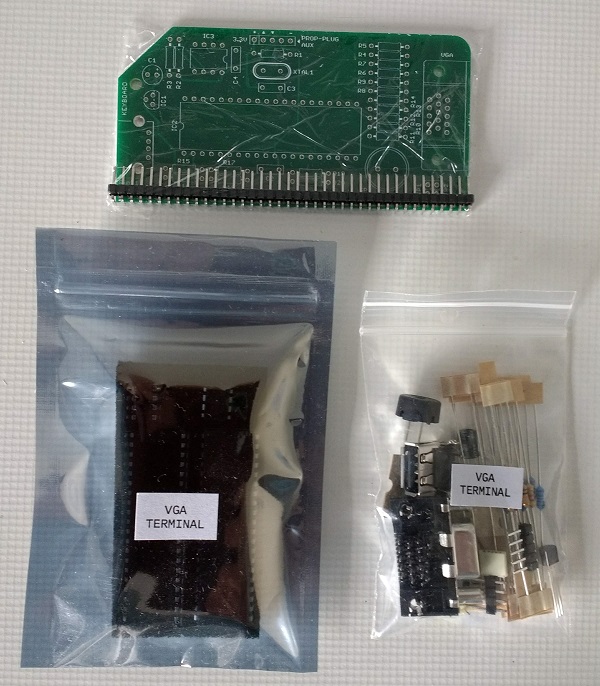
All the parts required to assemble the terminal module are included in the kit. A single sheet of instructions is included. This lists all the components and has a coloured picture showing the component placements. There is not a step by step assembly guide.

The first thing I did was sort out all the parts. There are quite a few different value resistors so I took great care to identify them before assembly.
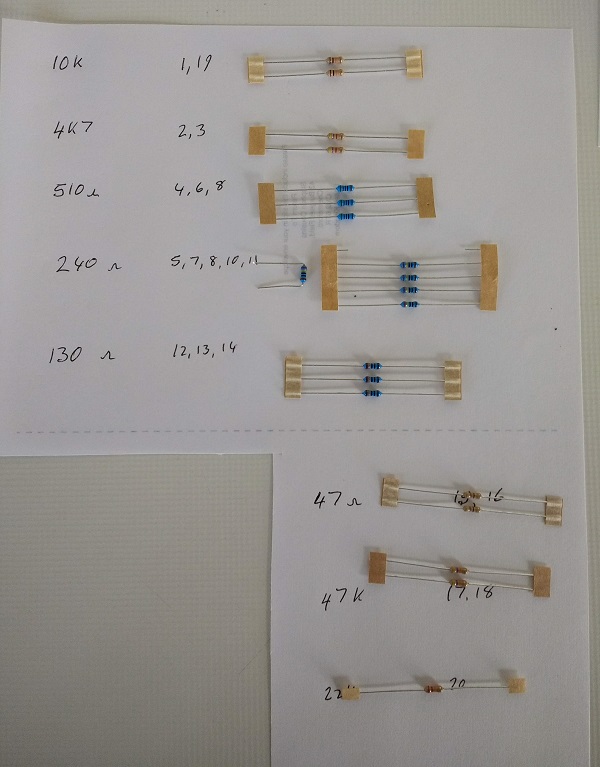
I started assembly by fitting, but not soldering, the resistors. I then checked them against the supplied picture before soldering.
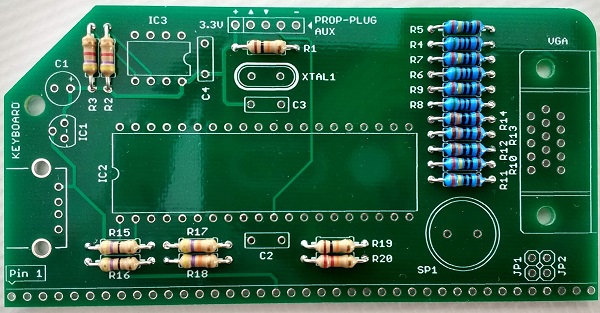
I then fitted the bus connector, followed by the IC sockets, and then all the other components in no particular order.

Note: I deliberately did not fit the supplied ‘prop-plug’ header pins. I have no use for them at the moment so I thought I’d leave my options open here.
Jumper shunts should be fitted at JP1 and JP2 in order for the serial receive and serial transmit signals on the bus to be used by the terminal module.
Testing
The first test only involved fitting the module to an RC2014 compatible backplane, connecting a VGA monitor, and applying power (5 volts). This should show a cursor at the top left of the monitor.
Next the module should be connected to a complete RC2014 style system. This system must have its serial TX and RX signals connected to the RC2014 backplane pins 35 and 36. The baud rate must be 115200 baud. Both a VGA monitor and a USB keyboard should be connected to the terminal module. Power up and you should be greeted with the usual sign on text on the monitor and the keyboard should work.
The terminal module has a settings screen which is accessed by pressing CTRL and F10 together.
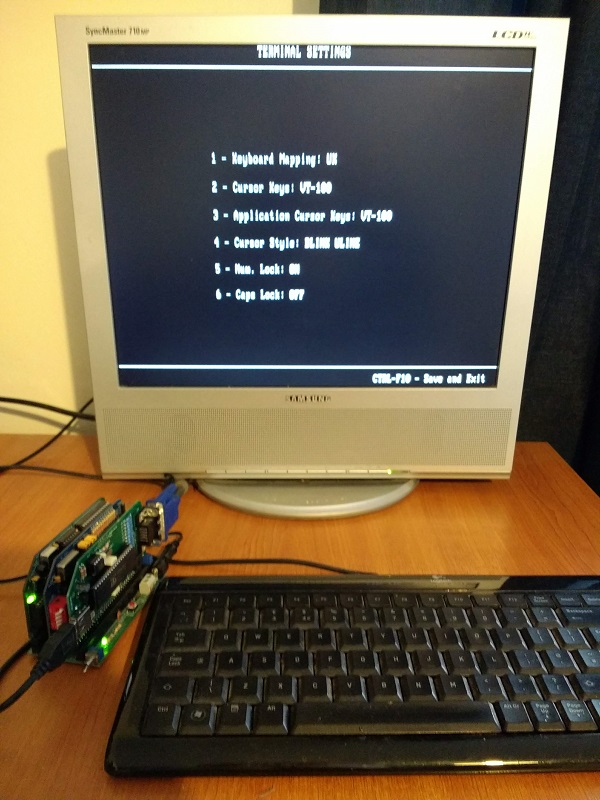
Limitations
Using the VGA Serial Terminal module does impose a few limitations that are not present when using a modern computer as a terminal.
Using a modern computer allows convenient file transfer using XMODEM etc. As the ‘real’ terminal does not have a filing system or file transfer tools it is only possible to transfer files using a second serial port connected to a modern computer. As a result I’d suggest the terminal module is best suited to running local software on a retro system that has already been fully configured. When setting up your retro system or when going software development work, a modern computer is better suited to being your terminal.
Another limitation is the terminal only provides 25 lines. I normally have more lines on my terminal software. One place this is an issue is the RomWBW startup text does not all fit on the screen.
Conclusion
Marco’s VGA serial terminal module is a great addition to an RC2014 based retro system. By liberating the retro system from the need for a massively powerful modern computer ‘terminal’ you have a more authentic 8-bit computer.
I highly recommend this kit. Great job Marco.